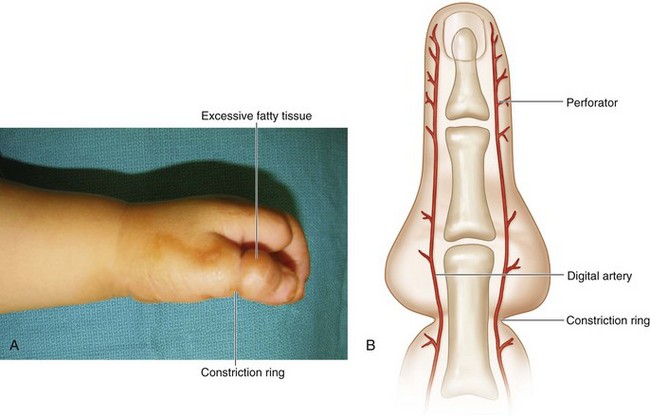Procedure 40 Correction of Constriction Ring
![]() See Video 33: Surgery for Constriction Band Syndrome
See Video 33: Surgery for Constriction Band Syndrome
Indications
 Constriction rings may be mild, moderate, or severe.
Constriction rings may be mild, moderate, or severe.
 Severe constriction rings will need release soon after birth on an emergent basis. Moderate rings can be corrected at a later age (6 to 9 months), when anesthesia is easier and safer and the structures are larger. The correction of mild rings is performed for aesthetic considerations and should be done before the child goes to school (3 to 4 years of age).
Severe constriction rings will need release soon after birth on an emergent basis. Moderate rings can be corrected at a later age (6 to 9 months), when anesthesia is easier and safer and the structures are larger. The correction of mild rings is performed for aesthetic considerations and should be done before the child goes to school (3 to 4 years of age).
Examination/Imaging
Clinical Examination
 The presence of distal lymphedema indicates a lack of sufficient subcutaneous layer to promote the lymphatic flow. Most of the lymphedema will subside within a few months after correction of the constriction ring.
The presence of distal lymphedema indicates a lack of sufficient subcutaneous layer to promote the lymphatic flow. Most of the lymphedema will subside within a few months after correction of the constriction ring.
 In children with bilateral constriction ring syndrome, the severity of the deformity of one limb is independent of the other.
In children with bilateral constriction ring syndrome, the severity of the deformity of one limb is independent of the other.
Surgical Anatomy
 The constriction ring can extend from the skin to as deep as the bone. Affected structures may involve lymphatics, nerves, and the vascular system, and the constriction ring can result in lymphedema, neurologic symptoms, and amputation.
The constriction ring can extend from the skin to as deep as the bone. Affected structures may involve lymphatics, nerves, and the vascular system, and the constriction ring can result in lymphedema, neurologic symptoms, and amputation.
 The soft tissue and skeletal structures are always normal proximal to the constriction ring, but the soft tissue distal to the ring can present with varying degrees of edema (Fig. 40-1A). The growth centers distal to and just proximal to the constriction can often be injured, resulting in hypoplasia. Nerve palsies have been associated with the bands and are present at birth.
The soft tissue and skeletal structures are always normal proximal to the constriction ring, but the soft tissue distal to the ring can present with varying degrees of edema (Fig. 40-1A). The growth centers distal to and just proximal to the constriction can often be injured, resulting in hypoplasia. Nerve palsies have been associated with the bands and are present at birth.
 Excess subcutaneous fat both proximal and distal to the constriction ring should be excised.
Excess subcutaneous fat both proximal and distal to the constriction ring should be excised.
 The arterial blood supply of the part distal to the constriction ring arises from perforators that originate from the main artery located in the deep layer. This blood supply can be maintained because of the intact main artery and its venae comitantes (Fig. 40-1B).
The arterial blood supply of the part distal to the constriction ring arises from perforators that originate from the main artery located in the deep layer. This blood supply can be maintained because of the intact main artery and its venae comitantes (Fig. 40-1B).








